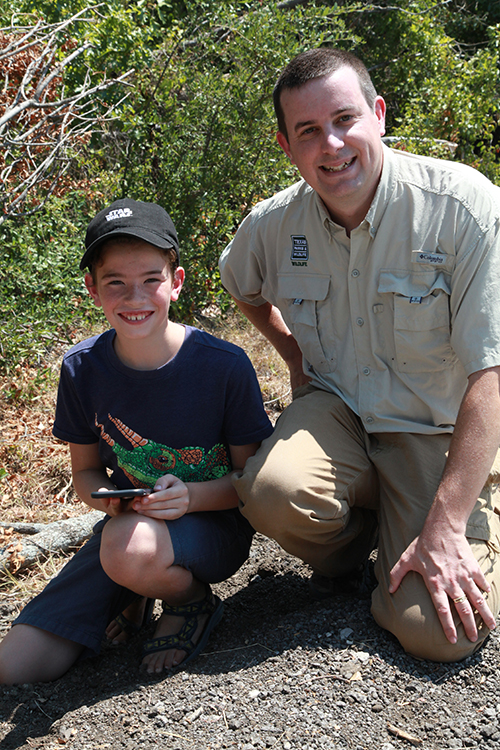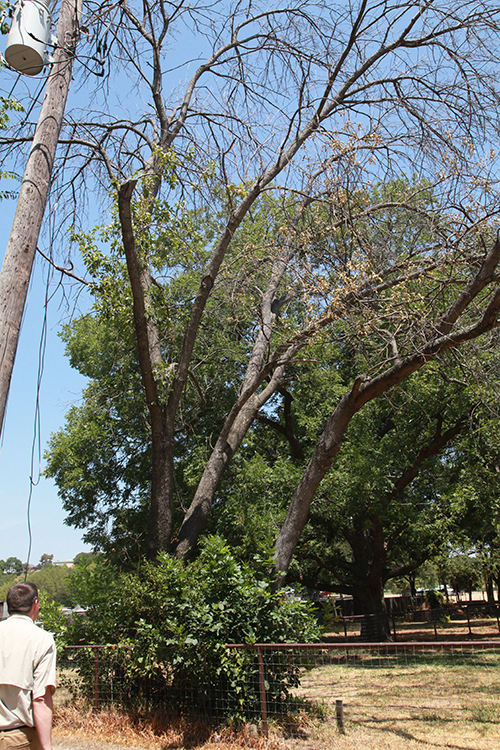
Two Good Sams. Sam Hunt (left) and Sam Kieschnick, Texas Parks and WildLife biologist, were responsible for discovering the first emerald ash borer in north-Central Texas.
Last summer Texas Parks and Wildlife biologist, Sam Kieschnick, was going through pictures on iNaturalist and saw a picture of an insect taken by someone he knew. It was a shot of a shiny green beetle that 10-year-old nature enthusiast, Sam Hunt, had snapped in his own driveway near Eagle Mountain Lake in west Tarrant County.
Something about the picture bothered biologist Sam, so he forwarded it to colleagues who were experts in a group of insects called buprestid beetles. The expert consensus seemed to be that 10-year-old Sam had taken the first picture of an emerald ash borer in the central Texas area.
Emerald ash borer is an exotic beetle that has steamrolled its way through the upper Midwest states since its discovery in 2002. As it spread through Michigan, Ohio, Indiana and other states, something became clear. This insect had the potential to be one of the greatest forest disasters ever to hit the U.S. Not only did it kill millions of young and old ash trees, it appears to be poised to completely eradicate wild ash trees from most of the area it has invaded.
And now, it appeared, this same ash borer had jumped from Louisiana and a few Texas border counties to the outskirts of Fort Worth, part of one of the largest urban forests in the state.
One blurry picture, however, is not enough when it comes to making costly decisions about whether to institute quarantines or alert the public to consider making costly insecticide applications to their trees. An actual sample would be needed.
Meanwhile, the photo stirred interest among professionals at the Texas A&M Forest Service. Consequently, last summer TFS forester Allen Smith organized two expeditions to the area where 10-year-old Sam had taken his picture. On the second trip he and colleagues were able to collect beetle larvae from under the bark of dead ash trees from the neighborhood. This month those larvae were confirmed, via DNA testing, to be emerald ash borer.
How the beetle made its way to Tarrant county is still being investigated, but it’s likely that the beetles found this fall have been in the area for several years. It typically takes around three years to kill mature ash trees, and the infested neighborhood appears to already harbor many dead or dying ash trees.
The Texas Department of Agriculture is currently considering steps to declare Tarrant County, and possibly nearby counties, part of an emergency quarantine zone to prevent transport of any suspect firewood or tree trimmings to un-infested areas. This will require the cooperation of wood carvers, firewood distributors, utility and tree care companies, as well as the public. Although there is probably no way to keep the ash borer from eventually spreading throughout the state, efforts to stop accidental human transport will slow the spread of the beetles to your home.
Current recommendations developed from experience with the beetle in the Midwest suggest that valuable ash trees within 15 miles of a known ash borer infestation be preemptively treated for the pest. This would mean that many residents of Fort Worth and the nearby city of Weatherford should consider treating any valuable ash trees within the next 2-3 years.
Fortunately for us, ash trees make up a relatively small percentage (about 6%) of urban shade trees in the Dallas/Fort Worth area. But if you have a beautiful ash tree in your yard, and it provides good shade, you may want to consider treating it every one to three years to protect it from the emerald ash borer.
For most of us, it’s not yet time to panic. But keep in mind that as the borer nears your home you will be face with the decision whether to treat or not. Just keep in mind that if you don’t treat, you can probably kiss your ash goodbye. 😥
[Note: There is much good information on ash tree treatment online. However, we will be following up with Texas treatment recommendations in coming months. Stay tuned.]
